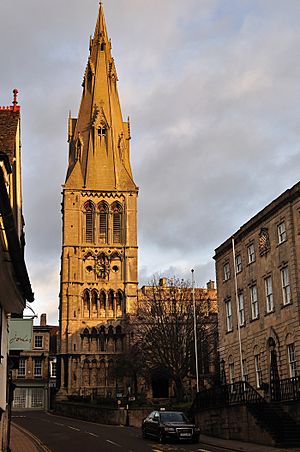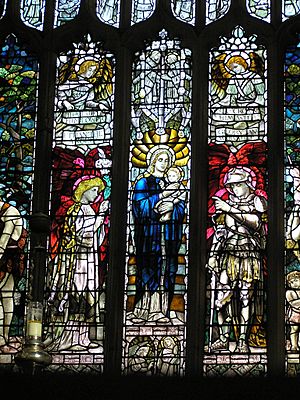St Mary's Church, Stamford facts for kids
Quick facts for kids St Mary's Church, Stamford |
|
|---|---|

St Mary's Church, view from St Mary's Hill
|
|
| Denomination | Church of England |
| Churchmanship | Anglo Catholic |
| Website | www.stamfordbenefice.com/ |
| History | |
| Dedication | St Mary |
| Specifications | |
| Spire height | 168 feet (51 metres) |
| Administration | |
| Parish | Stamford St Mary and St Michael |
| Deanery | Stamford |
| Archdeaconry | Archdeaconry of Boston |
| Diocese | Diocese of Lincoln |
| Province | Province of Canterbury |
St Mary's Church, Stamford is a historic church in Stamford, Lincolnshire, England. It belongs to the Church of England. The church stands on a hill called St Mary's Hill. This hill was once part of the old Great North Road. It leads down to the river, across from The George Hotel.
Contents
History of St Mary's Church
Building the Church Over Time
The main part of St Mary's Church was built a very long time ago, in the 12th century. That's over 800 years ago! Later, in the 13th century, the tall tower was added. Then, in the 14th century, the beautiful spire was built on top of the tower.
The tower itself is 78 feet (24 metres) high. The spire adds another 90 feet (27 metres) on top. This makes the total height of the church 168 feet (51 metres).
Saving the Spire
In 1741, a person named William Stukeley suggested that the spire needed repairs to stop it from falling down. The repair work finally happened in 1788. A builder named Charles Haynes used strong iron straps to fix it. The spire was made even stronger in 1913 with new metal bars placed inside.
The Oldest Parts of the Church
One of the most special parts of St Mary's is the Corpus Christi Chapel. This chapel was built in the 14th century, though some parts are even older, from the 13th century. It is the earliest part of the church that still stands. This chapel has a connection to an old school that later became Stamford School.
The ceiling of this chapel is very rare. It's a decorated medieval "wagon vault" ceiling. This type of ceiling looks like the inside of a covered wagon. You can find many like it in the west of England, but very few in the East Midlands.
Changes and Memorials
In 1880, a new room called the vestry was added to the church. Later, in 1890, new screens and an altar were put in. The ceilings of the chancel and sanctuary (the areas near the altar) were also decorated. These changes were designed by J. D. Sedding.
In 1921, a special wooden cross, called a rood, was placed above the screen near the altar. This was done to remember the men from the church who died in the First World War. A plaque with their names is near the pulpit.
After the Second World War, in 1948, a screen was added to the tower arch. This was to remember everyone who served in that war.
St Mary's Church Today
Today, St Mary's Church follows a specific tradition within the Church of England called Anglo-Catholic. This means it has some practices that are similar to the Roman Catholic Church. The church also receives special guidance from a bishop called the Bishop of Richborough.
Stained Glass Windows
St Mary's Church has some amazing stained glass windows. One of the most famous is the Lady Chapel east window. It was designed by Christopher Whall in 1891. This was the first big project Whall did on his own.
Whall said this window was "the foundation and beginning of everything" for his career. He designed and made the window himself, with only one helper. They even worked in a cowshed that he used as a workshop! To make the figure of St Michael, Whall made a suit of armor out of papier-mâché, and his assistant had to wear it!
The window shows different figures. In the main parts, you can see Adam and Eve. In the middle, there are angels Gabriel and St Michael, along with the Virgin Mary and baby Jesus. The smaller parts at the top of the window show scenes from the Mysteries of the Rosary. At the very top, you can see the Coronation of the Virgin Mary.
Another window in the Lady Chapel, on the north side, was made in 1893. This one was a joint effort between Christopher Whall and Louis Davis.
The Church Organ
St Mary's Church has a large organ that was built in 1829 by a company called Gray. It was first placed in a gallery at the back of the church. In 1852, it was moved to the end of the south aisle.
Over the years, the organ has been updated. In 1984, it got a new "electro-pneumatic action." This is a modern system that helps the organ pipes make sound. The organ was also turned so that its sound could reach both the main part of the church (the nave) and the area near the altar (the chancel).


